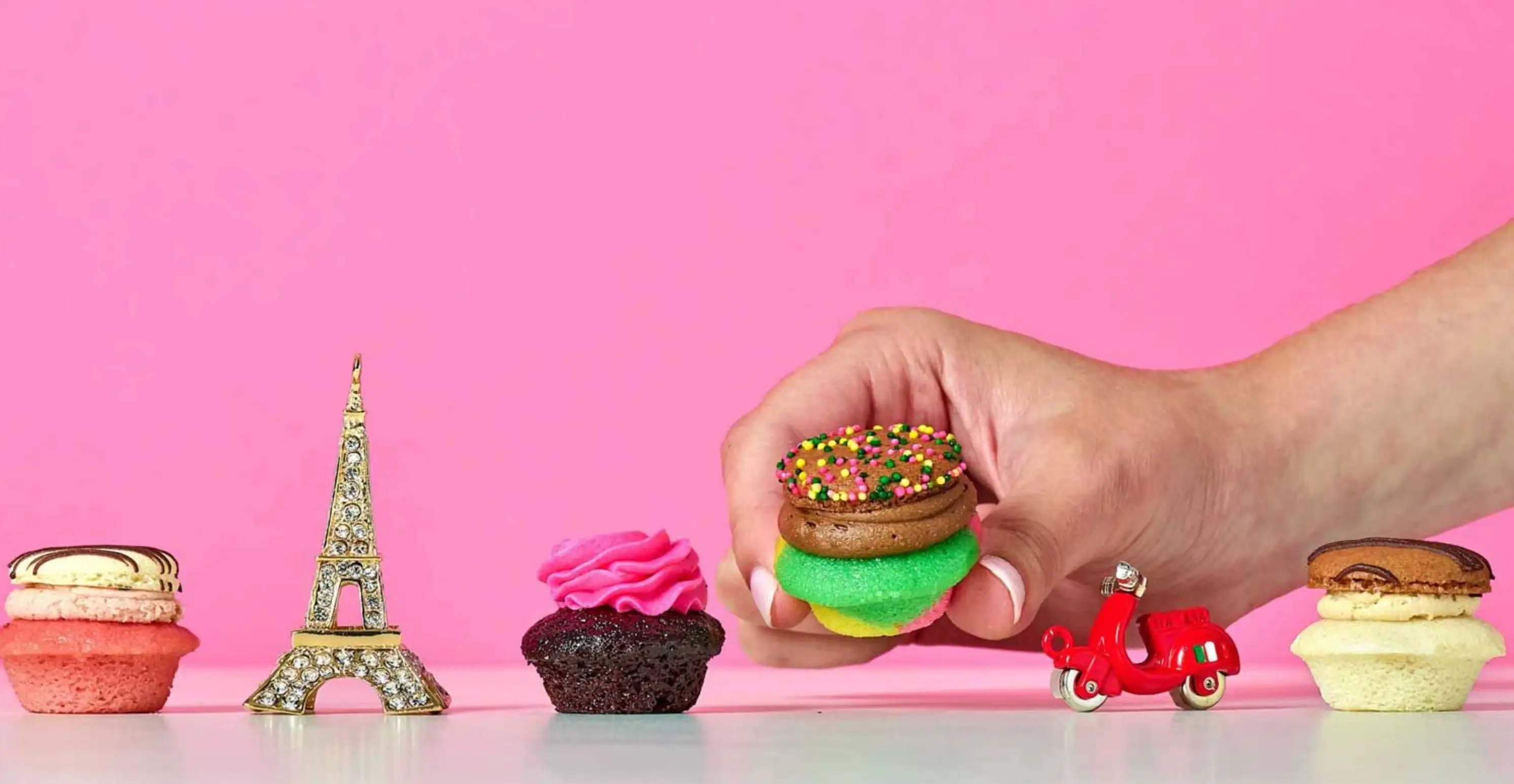The Top 15 Biggest Rebrands and Comebacks of 2023 That Will Guide 2024
Updated on
Published on

When a big company announces its intention to rebrand, the world collectively holds its breath, eagerly anticipating the transformative journey that lies ahead. Howcome? Consumers recognize that a rebrand is so much more than the reveal of a new logo; it signifies a comprehensive strategic overhaul, wielding the power to reshape public perception at its core.
This year, social media's interaction with consumers' ever-evolving preferences is guiding the marketing landscape. It's an intriguing fusion of traditional methods with cutting-edge concepts. Brands are demonstrating resilience in the face of challenges through successful rebrands or comebacks. The key in either case is a rebrand, which is a crucial step in remaining relevant and drawing in customers. Marketing success stories stem from a brand's fundamental character and its capacity to resonate with the goals of contemporary consumers, rather than just a superficial revamp. Those who can change with the times, grow with them, and capitalize on shifting trends are the real winners. It's about responding with quickness, reviving plans, and mastering the art of reinvention. These are not only stories of effective marketing; they also reveal how dynamic the field is. Seeing new companies carve out a distinct place in the market while established brands rediscover themselves adds an intriguing element to the world of marketing.
Rebranding and The Impact of Social Media Trends
Rebranding has come a long way from just a simple makeover. It has evolved significantly, thanks to the widespread impact of social media. It has gone beyond just visual updates and now blends seamlessly with the digital world of our online environments. Social media has become like a canvas where brands can paint intricate narratives and create personal connections with their audiences. For rebranding, it's crucial to focus on things like visual aesthetics, storytelling skills, and engagement strategies. It's not just about changing logos and colours; it's about how a brand can tell a captivating story and evoke feelings for a consumer.
Social media is constantly changing, which makes things more complicated. Trends come and go quickly, influencing the stories that brands tell in the present moment. Rebrands that are successful don't just go along with the latest trends; they actually play a role in influencing or creating them. Nowadays, conversations between brands and their audience are no longer one-sided. Brands actively engage in dialogue with their audience. When there is two-way communication, it helps people feel like they belong. And when brands are authentic, it forms a strong foundation for their relationships with consumers. It can be quite challenging to keep the brand image consistent across various social platforms. Adaptation is important to stay relevant, but it's equally important to remain true to the core values and brand identity. Having consistent branding helps create a sense of trustworthiness in the ever-changing world of social media.
The Biggest Rebrands and Comebacks of 2023
In 2023, we observed many noteworthy rebrands and comebacks that spanned strategic transformations and nostalgic resurgences. They offer invaluable lessons for brands navigating the intricacies of today's consumer expectations. Let's explore the narratives behind the most successful and standout rebrands of 2023.
1. Crocs: From Ugly to Iconic

Crocs orchestrated a phenomenal comeback through strategic celebrity collaborations. Partnerships with global icons like Justin Bieber and Post Malone propelled Crocs into the realm of fashion-forward footwear. The brand's ability to align with influential figures marked a strategic shift, turning the once-unattractive footwear into an iconic phenomenon.
Central to Crocs' resurgence in 2023 was the active involvement of Gen Z. The younger demographic, known for its penchant for authenticity and individuality, embraced Crocs as a symbol of self-expression. Crocs changed from a practical shoe to a fashion statement on social media platforms by introducing Crocs pins that can be clipped on the shoe to costumize every pair. The Crocs comeback story offers a playbook for brands seeking revival. Embracing collaboration, especially with influential figures relevant to the target audience, and adding the custimizability option proved instrumental. Furthermore, Crocs showcased the importance of adaptability, shedding its conventional image to align with the evolving preferences of a dynamic consumer base.
2. Barbie: Reinventing the Icon
Barbie, a brand synonymous with dolls for decades, encountered a sales and relevance downturn between 2014 and 2016. In response, the brand underwent more than just a cosmetic makeover; it orchestrated a comprehensive reinvention to align with modern values and inclusivity. Mattel, the creative force behind Barbie, made a move toward inclusivity by introducing new skin tones, body types, careers and an entire movie. This strategic shift aimed to authentically mirror the diversity of its audience, meeting contemporary expectations of representation. Notably, Barbie's reinvention included a highly successful movie that not only captured hearts but significantly contributed to the brand's resurgence in both sales and market relevance. The decision to embrace diversity and redefine beauty standards positioned Barbie not merely as a toy but as a powerful symbol of empowerment and inclusivity.
3. Birkenstock: The '90s Revival
Birkenstock, a brand deeply associated with comfort, experienced a revival in mainstream fashion. The '90s style resurgence and the 'dad shoe' trend provided the perfect backdrop for Birkenstock to reclaim its status as a fashion statement. Social media played a pivotal role in Birkenstock's revival. Viral trends, fueled by influencers and fashion enthusiasts, propelled the brand back into the spotlight. The simplicity and authenticity of the brand's design resonated with the digital audience, turning Birkenstock into a symbol of casual, laid-back elegance. Birkenstock's collaboration with high-end brands like Dior and Manolo Blahnik added a touch of luxury to its image. The embrace of the 'dad shoe' trend further solidified Birkenstock's position as a versatile and stylish choice. The brand's ability to leverage both nostalgia and contemporary fashion trends contributed to its triumphant return.
4. Ugg Boots: Y2K Nostalgia

Ugg boots, once synonymous with early 2000s fashion, made a triumphant return thanks to the Y2K fashion trend. The nostalgia associated with the distinctive sheepskin boots became a key element in their resurgence. Ugg's parent company, Deckers, played a crucial role in orchestrating the brand's comeback. By capitalizing on the Y2K trend and strategically positioning Ugg boots as a nostalgic fashion statement, the brand witnessed a spike in new customers, particularly among the 18- to 34-year-old demographic. TikTok influencers and celebrities played a pivotal role in reviving Ugg's' image. Collaborations with trendsetters and the seamless integration of Ugg boots into influencer lifestyles contributed to the boots' resurgence as a symbol of comfort and style.
5. Pepsi: Maximalism After 14 Years
After 14 years without a visual overhaul, Pepsi embraced maximalism in a bold rebranding move. Muted tones were replaced with electric colours, and a new "pulse" motif was introduced. This strategic shift aimed to position Pepsi for the next chapter in digital marketing. The overhaul saw Pepsi break free from muted aesthetics and embrace vibrant, electric colours. The introduction of the "pulse" motif added a dynamic visual element, aligning the brand with contemporary design trends. Pepsi's bold approach sought to capture the attention of a digitally immersed audience. Pepsi's visual overhaul had profound implications for brand perception and market presence. The maximalist design resonated with a younger demographic, positioning Pepsi as a brand in tune with modern aesthetics. The rebranding aimed to set the stage for Pepsi's digital marketing endeavours, marking a significant chapter in the brand's visual evolution.
6. 7-Eleven (Slurpee): A Refreshing Campaign
7-Eleven's Slurpee, a nostalgic beverage choice, underwent a refreshing transformation with the "Anything Flows" campaign. The campaign's focus on diversity and self-expression sought to reposition Slurpee as more than just a drink; it became a symbol of individuality and freedom. Each facet of the "Anything Flows" campaign centres on diverse representation. The inclusion of individuals from various backgrounds embracing self-expression aligns with the evolving values of younger audiences. 7-Eleven aimed not only to sell Slurpees but to foster a sense of connection and inclusivity. The success of the campaign was measured not just in sales but also in the resonance it created with younger audiences. 7-Eleven's approach serves as a lesson for brands targeting youth: authenticity, diversity, and a celebration of individuality can transform a product into a cultural phenomenon.
7. Chips Ahoy!: Cookies and Digital Revitalization
Chips Ahoy! embarked on a digital revitalization journey to stay relevant with Gen Z. The brand leveraged digital platforms to connect with the younger demographic, recognizing the shift in consumer behaviour toward online engagement. A key element of Chips Ahoy!'s strategy was the introduction of an animated spokesperson, Chip, on various digital platforms. This approach added a playful and relatable touch to the brand's identity, resonating with Gen Z's preference for interactive and visually engaging content. Chips Ahoy! went beyond traditional marketing by planning themed events. This innovative approach aimed to create immersive brand experiences and position Chips Ahoy! as more than just a cookie—it became a source of entertainment and shared experiences.
8. Kraft Singles: Bold Colours and Packaging

Amidst a period of high inflation, Kraft Singles undertook a bold brand refresh. The significance of this move extended beyond visual aesthetics; it was a strategic response to economic challenges and a commitment to maintaining momentum in a shifting market. Bold colours and redesigned packaging became the visual language of Kraft Singles' refresh. The brand aimed to stand out on the shelves and capture consumer attention with a fresh, modern look. The redesign signalled adaptability and a proactive stance in the face of economic uncertainties. Kraft Singles' bold move was not just about visual appeal; it was a statement of resilience. By acknowledging market challenges and responding with a proactive refresh, the brand aimed to maintain momentum and reassure consumers of its commitment to quality and innovation.
9. Stella Artois: Shifting Dining Trends
Stella Artois, a brand traditionally associated with premium beer, underwent a strategic repositioning to align with shifting dining trends. Recognizing the evolving habits of consumers, the brand pivoted toward a more casual dining experience. The shift in brand positioning was a response to changing consumer behaviours, especially in the realm of dining. By emphasizing a more casual and accessible image, Stella Artois sought to appeal to consumers seeking a balance between quality and relaxed dining experiences. Stella Artois' success hinged on the synergy between its updated brand image and the changing dynamics of consumer behaviour. As dinner habits evolved from formal to casual, the brand's repositioning reflected an understanding of contemporary lifestyles and a proactive approach to staying relevant.
l0. Peloton: A Fitness Brand's Revamp
Peloton, amidst a 22% drop in revenue, embarked on a brand revamp strategy. The introduction of a free membership tier aimed to make Peloton more accessible, responding to the challenge of declining revenue and the need to connect with a broader audience. The unveiling of Peloton Gym represented a significant leap in accessibility. By diversifying its offerings, Peloton aimed to cater to a wider demographic and provide value beyond its traditional fitness content. This strategic move was a response to the changing landscape of digital fitness and consumer expectations. Peloton's brand revamp was not just about adapting to challenges but proactively reshaping its offerings. In the face of a competitive market and economic uncertainties, Peloton's strategy exemplifies the importance of innovation and staying ahead of evolving consumer preferences.
11. Reebok: Basketball and Fashion
Reebok seems to be staging a remarkable comeback, tapping into the thriving market for retro shoe releases and leveraging its rich history. The Reebok Answer III, a cult favourite from 1996 that Allen Iverson wore while playing for the Philadelphia 76ers, has recently undergone a makeover that demonstrates the brand's strategic decision to bring back enduring classics. This reflects a broader strategy, with Reebok focusing on its basketball division's rebirth, appointing Iverson as the vice president of basketball and enlisting Shaquille O'Neal as president, with plans for a full relaunch in early 2025. By delving into its archive and reissuing sought-after models like the Answer III and Shaq Attaq, Reebok aims to tap into the nostalgia-driven retro market, aiming for success akin to the legendary Jordan Brand. These revival efforts signal a promising direction for Reebok as it seeks to reclaim its position in the basketball world and cater to the appetite for classic sneaker releases.
12. True Religion: Denim to Lifestyle

True Religion, once synonymous with high-end denim, embarked on a transformative journey in 2023, redefining itself as a lifestyle brand. This shift marked a departure from its traditional identity, necessitating a strategic pivot. Central to this evolution was the appointment of Kristen D’Arcy as the first Chief Marketing Officer, bringing a wealth of experience from her tenure at American Eagle Outfitters, Ralph Lauren, and PacSun. As CMO, her strategic vision aimed to engage not only existing loyalists but also a new generation of consumers. D’Arcy's expertise became instrumental in crafting a narrative that seamlessly blended the brand's heritage with contemporary aspirations. The unveiling of the "Style is a Gift" holiday campaign became a cornerstone in True Religion's quest for relevance. The campaign, featuring prominent figures like Quavo and India Love, transcended conventional marketing by tapping into the cultural zeitgeist. Gen Z, known for their discerning taste and affinity for authenticity, became a focal point in True Religion's engagement strategy. The campaign's success hinged on its ability to resonate with Gen Z's values, emphasizing individuality, inclusivity, and self-expression. The holiday campaign not only showcased the brand's adaptability but also positioned it as a cultural influencer.
13. Nokia

Nokia, a pioneer in mobile devices, has embarked on a significant rebrand, unveiling a refreshed logo with a simplified and angular design, marking its first rebrand in 45 years. Nokia's rebranding strategy aims to position itself as a "B2B technology innovation leader realizing the potential of digital in every industry." The updated logo features a minimalist and angular design, departing from the blocky 1979 version. The recognizable deep blue hue has been brightened, and the redesign emphasizes collaboration, reflecting Nokia's commitment to networking expertise, technology leadership, and pioneering innovation. This dynamic rebrand symbolizes a modern and energized Nokia, underscoring its values and purpose in the ever-evolving tech landscape.
14. Twitter/X: The Rebrand
In a seismic shift, Twitter, under the visionary leadership of Elon Musk, has embarked on an audacious rebranding journey. A striking "X" on a black background has taken the place of the platform's iconic blue bird logo, which has been a symbol since 2012. This radical departure signifies Musk's ambitious vision to transform Twitter into an all-encompassing "everything app" that goes beyond traditional social media. The X logo, resembling the Unicode character "Mathematical Double-Struck Capital X," was chosen through a contest, raising eyebrows and sparking debates about its simplicity and departure from the familiar blue bird. While some praise the sleek modernity of the X, others express concern about its generic appearance and the challenge of severing ties with a symbol deeply embedded in Twitter's brand identity. Musk's overarching plan includes integrating audio, video, messaging, payments, and AI-powered technologies, positioning X Corp. as a versatile and interactive social media ecosystem.
However, this bold move is not without risks, as Twitter risks alienating its loyal user base and faces stiff competition from emerging platforms like Meta's Threads. The coming months will be crucial in determining whether X can carve out a unique space in the dynamic social media landscape and become as iconic as the blue bird it replaces. As Musk steers Twitter into uncharted territory, the platform's evolution into X Corp. promises both opportunities and challenges in the quest for an "everything app." Only time will reveal the true impact of this transformative chapter in Twitter's history.
15. Nickelodeon

Nickelodeon's recent rebranding initiative, focusing on its iconic '90s programming block "The Splat," is poised to trigger waves of nostalgia among fans of classics like "Rugrats," "Hey Arnold!" and "Doug." The revamped Splat logo, with its modernized and vibrant design, is a nod to the past while embracing a polished and contemporary aesthetic. Nickelodeon strategically weaves together old and new content, showcasing beloved classics alongside fresh shows inspired by the Splat brand, like "The Loud House" and "SpongeBob SquarePants." The campaign is not merely about a visual facelift; it's a journey back to the '90s, aiming to re-engage with the original audience while attracting a new generation. This nostalgic resurgence is part of Nickelodeon's broader strategy to celebrate its heritage while looking ahead, recognizing the potency of nostalgia in driving consumer interest. By modernizing its brand image through updated graphics and a new logo, Nickelodeon aims to create a seamless and recognizable brand identity across all platforms, from television to social media and merchandise. The move is not just about reconnecting with a loyal fan base; it's a strategic adaptation to stay relevant in an ever-evolving entertainment landscape. The blend of classic and contemporary content not only satisfies existing viewers but also introduces Nickelodeon to a new generation, solidifying the network as one unafraid of change while cherishing its timeless roots.
Strategies for Brands Eyeing a 2024 Rebrand
Unprecedented disruption that has occurred over the last five years, ranging from issues brought on by the pandemic to the revolutionary potential of artificial intelligence to change the way that buyers and vendors engage. Under increasing pressure, chief marketing officers (CMOs) are looking for creative ways to differentiate their companies and build engagement and trust. Four innovative methods are leading the charge to redefine the marketing world for business owners. As brands move beyond traditional interactions and transition from disconnected experiences to connected journeys, digital engagement takes front stage. The focus lies in crafting unique experiences that have a deeper meaning. Personalized online experiences, interactive webinars, and virtual reality demos are becoming standard practices that encourage participation above and beyond the surface. In addition, the incorporation of artificial intelligence (AI) has become a transformational force rather than just a catchphrase. Brands that use AI gain a significant advantage in a variety of areas, including automated customer service, tailored suggestions, and predictive analytics. The potential to accurately predict market trends, comprehend client behaviour, and grasp opportunities is unlocked for those who adopt AI quickly.
Video marketing optimization is becoming a powerful tactic, with many companies customizing their content to stand out in the digital clutter. In addition to commercial videos, educational programs, behind-the-scenes looks, and client endorsements take centre stage. In the meantime, the move to allow self-service is consistent with other decision-makers becoming more like consumers. Giving consumers the resources they need to locate what they need or modify items to meet their needs satisfies their growing need for independence. Lastly, being active on niche platforms catering to specialized communities allows brands to foster a deeper connection with a dedicated audience. Whether it's a platform centred around a particular hobby, lifestyle, or industry, the key is to understand where the target audience congregates and engage authentically.
As we reflect on the dynamic landscape of 2023, notable rebrands and comebacks have reshaped the narrative of the marketing sphere. From the iconic resurgence of Crocs to True Religion's transition into a lifestyle brand, each success story carries unique lessons. The thread that binds these narratives is the ability to evolve authentically, resonating with the pulse of modern consumers. For brands navigating the dynamic market, the key takeaways from the triumphs of 2023 are clear. Authenticity is non-negotiable, and consumer engagement goes beyond transactions; it's about fostering a community. The digital realm is not just an avenue; it's a playground for creativity and connection. Inclusivity, collaboration, and adaptability are not mere buzzwords; they are the pillars of resilience. As we gaze ahead into 2024, the trends and possibilities in brand reinvention continue to evolve. The fusion of technology and storytelling will shape immersive brand experiences. The exploration of new social media horizons will redefine how brands connect with diverse audiences. The roadmap to a successful renaissance lies in understanding that reinvention is not a destination; it's an ongoing journey of adaptation, innovation, and, above all, authenticity.
Creating and building a brand requires a delicate balance of understanding cultural nuances, trends, and consumer preferences. Brand Vision Marketing, as a professional web development agency, recognizes the importance of these distinctions. With expertise and experience, we ensure that your website is not just a digital presence but a tailored experience that resonates with the target audience.







